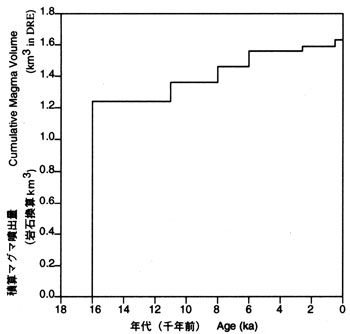Nasu Volcano
Introduction / Geology of Nasu volcano and environs / Outline of Nasu volcano
Rocks of Nasu Volcano
Eruptive history and mode of eruption of Chausudake Volcano
Eruptions of 1408 - 1410 / Eruptions of recent times
Surveillance of volcanic activities / Prediction of future activities
Acknowledgments / References
![]() PREV
PREV ![]() NEXT
NEXT
Surveillance of volcanic activities / Prediction of future activities
Surveillance of volcanic activities
Nasudake Volcano Observatory of Utsunomiya Regional Meteorological Station is located in the city of Kuroiso at SE foot and is engaged in telemetric monitoring 24 hours/7days on seismic activity using seismograph set up 1.9 km ESE of Chausudake summit. Also National Research Institute for Disaster Prevention at Tsukuba, Ibaraki Prefecture has a seismograph 1.2 km NE of Chausudake summit and engaged 24 hours / 7 days surveillance telemetrically.
Prediction of future activities
Large eruption with rock-equivalent volume exceeding 1 km3 from Chausudake occurred only once at the earliest stage of its development ( about 160,000 yBP ) and it seems that the scale tends to become smaller with time ( ![]() Fig. 5 ). Assuming that this trend continues the possibility of large scale eruption may be small. On the other hand, medium scale eruptions with rock-equivalent volume to be 10-1 - 10-2 km3 have repeated every couple of thousand years and the eruption of this scale may repeat in the future. The mode of medium scale eruptions is quite likely to be Vulcanian accompanying pyroclastic flows and lava flows which may directly or indirectly cause disaster at the foot. However, explosive magmatic eruptions do not occur suddenly but would be preceded by phreatic activity several years in advance. Last medium scale eruption occurred in 1408 - 1410 and it is only 600 years since. Frequency of small scale eruptions ( rock-equivalent volume of 10-2 - 10-3 km3 ) not accompanied with outpouring of magma is estimated to be once every few hundred years. In small scale eruptions, a quantity of ash fall is expected around summit area and the ash deposits may change into debris flows along valleys. Last small scale eruption occurred only a hundred years or so ago. On the other hand, micro eruptions with rock-equivalent volume of less than 10-4 km3 would be the most likely type of activity at Chausudake. Last micro eruption occurred in 1963 and fumarolic activity at west side and NE side within the crater does not show any sign of abating at the moment. If eruption occurs, fall of volcanic blocks and lapilli is expected within a couple of hundred meters of the summit. This may cause disastrous consequence if sightseers are happened to be there at that time. However, those wouldn' t cause any damage to foot area directly or indirectly.
Fig. 5 ). Assuming that this trend continues the possibility of large scale eruption may be small. On the other hand, medium scale eruptions with rock-equivalent volume to be 10-1 - 10-2 km3 have repeated every couple of thousand years and the eruption of this scale may repeat in the future. The mode of medium scale eruptions is quite likely to be Vulcanian accompanying pyroclastic flows and lava flows which may directly or indirectly cause disaster at the foot. However, explosive magmatic eruptions do not occur suddenly but would be preceded by phreatic activity several years in advance. Last medium scale eruption occurred in 1408 - 1410 and it is only 600 years since. Frequency of small scale eruptions ( rock-equivalent volume of 10-2 - 10-3 km3 ) not accompanied with outpouring of magma is estimated to be once every few hundred years. In small scale eruptions, a quantity of ash fall is expected around summit area and the ash deposits may change into debris flows along valleys. Last small scale eruption occurred only a hundred years or so ago. On the other hand, micro eruptions with rock-equivalent volume of less than 10-4 km3 would be the most likely type of activity at Chausudake. Last micro eruption occurred in 1963 and fumarolic activity at west side and NE side within the crater does not show any sign of abating at the moment. If eruption occurs, fall of volcanic blocks and lapilli is expected within a couple of hundred meters of the summit. This may cause disastrous consequence if sightseers are happened to be there at that time. However, those wouldn' t cause any damage to foot area directly or indirectly.
